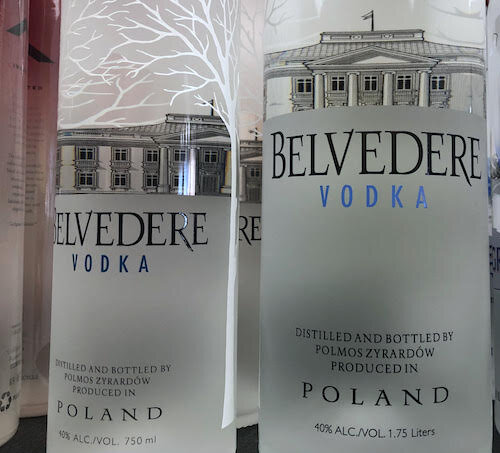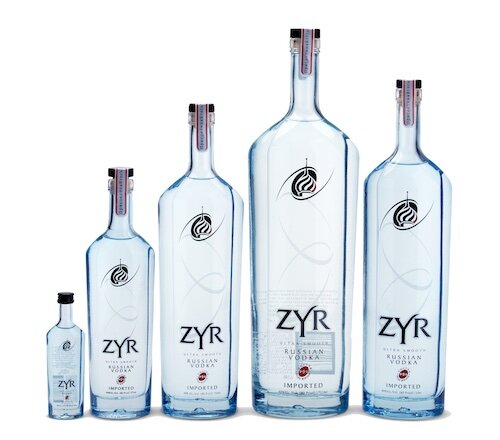Why It's Time to Stop Hating on Vodka
According to the Distilled Spirits Council, vodka is the “backbone of the spirits industry” making up about a third of all hard alcohol sold in the United States and globally. So why do you get the stink eye when ordering it at certain bars?
Vodka Haters
Some craft cocktail-focused bars don’t even serve vodka, such as gastropub Craft & Commerce in San Diego, having deemed it “a flavorless spirit” that lacks substance. According to Nicole Torres-Cooke, a leading vodka blogger VodkaGirlTX, the spirit has been getting a bad rap for a few years. She attributes its popularity in the 90s to the Sex and the City TV series, when the Cosmopolitan gained renewed attention, and then in 2014 when the Moscow Mule had made a resurgence in bars (although the cocktail originated in the early 1940s).
So, why do some bartenders turn their noses up over vodka? Torres-Cooke said that marketing and celebrity-endorsed products, such as P Diddy representing Ciroc might have turned bartenders off. But she also noted the shift to small-batch craft spirits over the past decade or so, when the emphasis shifted toward whiskey. “The reality is that whiskey has a lot more flavor,” says Markus Kypreos, founder of Blackland Distillery in Fort Worth, TX. A chef, lawyer, and certified sommelier, Kypreos got into the spirits business nearly two years ago to distill whiskey, but he now makes five spirits, including vodka.
The Rise of Craft Vodka
Kypreos said he’s proud of the vodka he makes because it’s clean and made with quality ingredients—in this case, Texas wheat. After proper distillation with state-of-the-art equipment, Kypreos cleans the water the vodka’s made with through carbon filters, reverse osmosis, and UV filtration, all of which soften its finish. H. Joseph Ehrmann, professional spirits judge, and proprietor at Elixir bar in San Francisco and Cocktail Ambassadors agree with Kypreos that the quality of the raw ingredients and the cleanliness of the water that vodka is made with play a huge role in aroma, taste, and drinkability.
What Flavor is Vodka?
Further Reading
What is Vodka Made From?
Torres-Cooke said she loves the versatility of vodka because it can be enjoyed neat or mixed into a cocktail without having an overpowering taste, and yes, she says, “vodka has taste,” adding “I also love the pureness of the spirit—water and the base ingredient.” And “As the saying goes,” she said, “vodka is just awesome water.” Ehrmann says when tasting and evaluating vodka in spirits competitions, there’s a level of granularity that takes a lot of focus because there’s not a lot there, but he also agrees that vodka does have a taste. “You are looking for very subtle nuances, and those flavor nuances can be either disrupted by bad distillation or enhanced by good distillation,” said Ehrmann.
Both Kypreos and Ehrmann also believe that since vodka is fairly cheap to make, depending on how you make it, there’s a lot of it being sold out there in bars and liquor stores, and a lot of it is sub-par, and often undrinkable. To prove the point, when Kypreos first launched vodka at his distillery, to educate his staff, he brought in bottles of some of the worst vodka out there as an example of what vodka should NOT taste like, and then he had them sip the vodka they’d be serving as a comparison—a stark difference in quality, texture, and taste.
Good Versus Bad Vodka
When it comes to poor quality vodka, that bitter taste and sting going down, and the hangover that follows comes from cheap ingredients and what Ehrmann refers to as “quick-and-dirty distillation.” Low-end vodkas are usually made with sugar, mass-produced, and sold in bulk. You’ll find them in huge plastic jugs at the liquor store, or in a dive bar’s well.
The price of vodka goes up not only with better distillation but with better ingredients. For example, vodkas made from corn are cheaper and have less depth than ones made with heirloom varietal grains. But it’s not to say all corn vodkas are bad. They’re not. When it comes to flavor and texture a premium vodka made from potatoes tends to have a good mouthfeel and creaminess to it, while wheat and other high-end grain vodkas are velvety and have hints of freshly baked bread. Vodka made from corn may be less flavorful since it’s a cheaper material, but some taste pretty good and contain a slight sweetness. Vodka made from grapes can also be subtly sweet and have a little more character than ones made from corn.
Vodka Cocktails
As far as mixing cocktails, vodka’s neutrality lends itself to a wide array of possibilities, but it can still stand standalone as a good sipper, as long as it’s served cold. Vodka should always be served ice cold. Don’t let anyone tell you otherwise. In an interview with Assistant Professor of Distilled Spirits at Oregon State University Paul Hughes, he said not only does temperature matter, but freezing vodka adds to its viscosity. He and vodka aficionados recommend serving it on ice or shaken or stirred and strained in a chilled glass with lemon zest or olives to enhance its flavor, depending on whether you’re going for that citrus or umami hint.
Vodka’s Future
Will vodka continue to dominate the market? Will there be a move toward less distillation in hopes of yielding more flavor? Will there be a focus on higher quality ingredients and less sugar and artificial ingredients? According to The Spirits Business sales shave been flat but value sales have risen and vodka is poised for a resurgence. Kypreos said he thinks there are trends towards less distillation, but when distillers don’t filter their vodkas to try to get some sort of character or taste, they stray too far, and that’s not vodka. “Just call it something else,” he said, since “the inherent nature of vodka is cleanliness and purity.” The only flavor or character of the vodka should come from is the base grain used from distillation, and the cleanliness of the water it’s made with. So ultimately, if you order a vodka that’s made with pure, quality ingredients, you are drinking a spirit that’s just as worthy as any other.
Expert Recommended Vodkas
Photo credit H. Joseph Ehrmann
Square One Organic Vodka
Ehrmann chose Square One as “an excellent sipping vodka” although he said he likes to mix it in cocktails, too. The mission behind this female-owned boutique organic spirits brand, founded by Allison Evanow, was to create innovative organic spirits with an eco-conscious mindset. The vodka is made with organic American-grown rye and pure, freshwater from the watershed of the Teton Mountains. As a standalone, it has black pepper, lemon oil and baking spices in the nose, with black pepper, warm cinnamon, toasted bread, and wet slate minerality on the palate.
Belvedere photo credit Alisa Scerrato
Belvedere’s Single Estate Rye Vodka Lake Bartezek
All of our experts recommended Belvedere’s original brand, which was launched in the early 90s as a premium vodka to sip on. A few years ago, Belvedere launched two single estate rye vodkas that are garnering a lot of attention in the spirits world. Made from rye in Poland’s Masurian Lake District, the influence of the soil, climate, and typography and climate shines through in this vodka, yielding a crisp, light scent and taste. When it first hits the palate, you get a vegetal hint that morphs into white pepper, ginger, and lemon zest. It’s a complex vodka that’s good as straight sipper. 2020 Gold NY International Spirits Competition
Ketel One
"Ketel One Jenever" by mededeler is licensed under CC BY 2.0
Netherlands-based vodka Ketel One has held a solid reputation for years (in business for over three centuries) for their reasonably priced, quality vodka. More recently, the company has become quite popular for their infusions, which contain no artificial flavors or sweeteners. (But don’t call it flavored vodka; it’s “botanical.”) Made from winter wheat grown in Europe, its blended with water to create mash before going through a column distillation process. The result is a silky mouthfeel and a subtle citrus aroma on the nose that leads to a smooth sweet taste with hint of spice on the finish.
Zyr
Courtesy of Zyr
Russian vodka Zyr, or “zeer,” means “reflection of the world.” It’s made from a blend of winter wheat and rye and made from non-GMO ingredients. Its texture is smooth and creamy, and it tastes like black bread out-of-the-oven with just a hint of sweetness. It’s award-winning and Boston bartending legend and musician Brother Cleve’s favorite Russian vodka.
2020 Double Gold NY International Spirits Competition
Chopin Vodka
Courtesy of Chopin
There’s a misconception out there that most vodka is made from potatoes, says Ehrmann, but it’s simply not true. Most vodkas are made from grains and other ingredients. That said, Chopin Potato Vodka is often lauded as one of the top potato brands in the industry (Chopin also makes a rye, a wheat, and family reserve). It’s Ehrmann’s choice, as far as potato vodka goes. A naturally gluten-free vodka, it’s creamy, earthy, and full-bodied flavor play off of hints of apple and vanilla. It works well as a standalone on ice, or in a celery spritzer.
Hanson Organic Vodka
Hanson photo credit Hanson of Sonoma
Hanson artisanal vodka is made in Northern California’s wine country, so you guessed it, it’s distilled from organic grapes. Made with fresh, local ingredients, this vodka is refreshing and light-bodied with subtle, fruity aroma that resembles lychee. This family-run distillery also makes over a half-a-dozen infused vodkas, ranging from cucumber to habanero (serious Bloody Mary material there), but the original is its flagship flavor and the base for all their vodkas. And, in the spirit of wine country, each bottle is numbered with a batch and bottle number so each one is traceable.
Tito’s
Tito's photo courtesy of Alisa Scerrato
The brand which markets itself as “America’s original craft vodka” is highly respected among consumers and spirts experts alike. It’s distilled six times and made in old-fashioned pot stills, so you end up with a smoothness that stands up to more expensive brands. Since it’s made from corn and reasonably no-frills branding (Tito created the simple label himself in 1994), it has an appealing price point but no sacrifice to quality, since it contains a clean, sweet corn taste. Torres-Cooke said when she started writing about vodka in 2014, it was a way to spread the vodka love and help promote Texas brands. She said she feels that Tito’s paved the road for all Texas brands by introducing the first vodka distillery in Texas.
Grey Goose
Grey Goose photo credit Alisa Scerrato
Grey Goose is a controversial vodka brand, either you love it or hate it. Even our experts gave us mixed reviews. Hughes agrees with Torres-Cooke that brand image of the vodka industry has changed the attitude of vodka over the years, and he attributes Grey Goose to that shift. The brand was first created in 1997 by American businessman and philanthropist, Sidney E. Frank, as a fancy, French vodka all wrapped up in a sleek, frosted bottle. It’s made from grain and was a favorite by many in the late 90s, early 2000s. Today, it’s some people’s go-to vodka, while others swear it has gone downhill since it was acquired by Bacardi in 2004. But the brand is still marketed by celebs to uphold its glam appeal. It’s a crystal clear, clean vodka, and for the price, around $30 for a 750ml, some find it worth it while others opt for more affordable brands that compare in taste. Torres-Cooke said she prefers the brand’s Grey Goose Ducasse because it “feels a bit elegant” and has a nuttiness to it.










